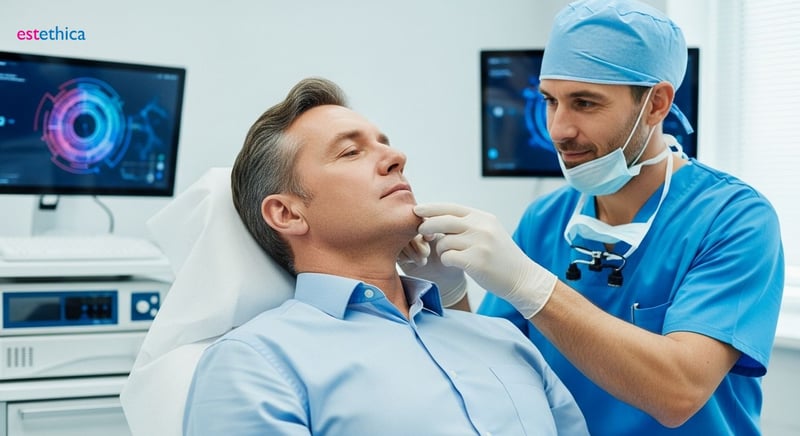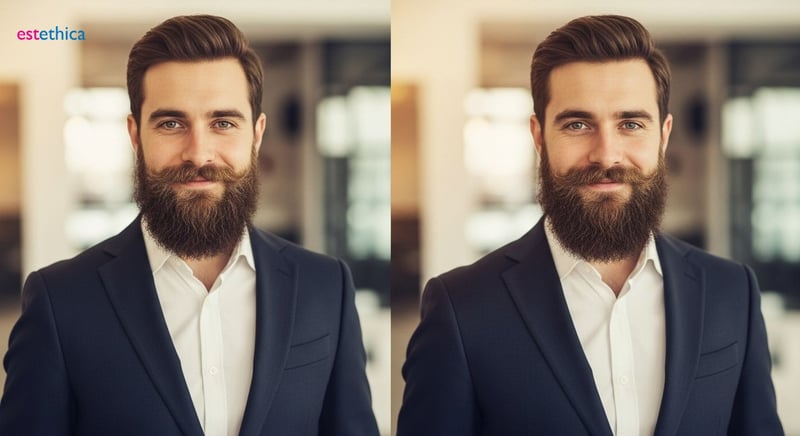Beard Restoration Revolution: Your Ultimate Facial Hair Guide
Discover how beard transplants using advanced FUE techniques can transform your appearance with natural-looking results.
Facial hair is a defining feature for many, symbolizing masculinity, maturity, and sometimes even individuality. However, not everyone is naturally endowed with the robust beard they might desire. For those looking to fill in patchy spots or craft a new look entirely, beard transplants offer a promising solution. In this guide, we delve into everything you need to know about facial hair transplants, focusing on their benefits, methods, recovery, and how to achieve natural-looking results.
Facial Hair Transplant: Is It Right for You?
Ideal Candidates for a Beard Transplant
Beard transplants are gaining traction, particularly among men aiming to enhance their facial aesthetics. Determining if you're a suitable candidate involves several factors. Typically, the best candidates are those who have patchy or thin beard growth. This can include men who have never been able to grow a full beard or those experiencing hair loss due to genetics or other conditions. A successful procedure often depends on the availability of healthy donor hair. A good candidate should have ample hair on other parts of their body, particularly the back of the head, which can be harvested and transplanted to the face.
Understanding these criteria is crucial for potential patients. It enables them to make informed decisions about whether a beard transplant aligns with their goals. The procedure itself is minimally invasive. Advances in technology have significantly improved its safety and effectiveness. The goal is to achieve natural-looking results that blend seamlessly with existing facial hair. For example, someone with a naturally light hair color might need fewer grafts to achieve a fuller look, while someone with darker hair might require more.
Key Considerations Before a Beard Transplant
- Hair Density: Assess the density of your existing facial hair and the desired outcome to determine the number of grafts needed.
- Donor Hair Availability: Ensure sufficient donor hair is available, usually from the back of the head, to cover the desired beard area.
- Overall Health: Good general health is essential for a successful transplant and recovery process.
Before undergoing a beard transplant, it's important to consider several factors. Hair density, donor hair availability, and overall health are crucial. A thorough evaluation by a qualified surgeon is necessary to assess suitability. This evaluation includes a detailed discussion of expectations and potential outcomes. For instance, a patient with diabetes needs to manage their condition to ensure proper healing. Another consideration is the patient's age, as younger patients might experience further hair growth changes. The surgeon will also evaluate the texture and color of the donor hair to ensure a natural match with the existing facial hair.

The FUE Beard Transplant Revolution: What to Expect
Understanding the FUE Technique for Beard Restoration
Follicular Unit Extraction (FUE) has transformed beard restoration by offering a minimally invasive solution that avoids linear scarring. In FUE, individual hair follicles are carefully extracted from a donor area, typically the back of the scalp, and then meticulously transplanted to the beard area. This technique allows for precise shading and filling in patchy areas, resulting in a natural-looking beard. Because the transplanted hairs grow in the same manner as natural facial hair, patients can expect a seamless integration and a significant enhancement in beard density and definition. FUE requires meticulous attention to detail, but modern techniques have made it highly effective in creating fuller, more defined beards.
FUE is particularly beneficial for those seeking a natural-looking beard without the visible scars associated with older transplant methods. The precision of FUE allows surgeons to mimic the natural angle and distribution of facial hair, ensuring that the transplanted hairs blend seamlessly with the existing beard. For instance, if a patient has a specific style in mind, such as a goatee or a full beard, the surgeon can strategically place the follicles to achieve the desired look. Another advantage is the minimal downtime, allowing patients to return to their normal activities shortly after the procedure. The results of an FUE beard transplant can significantly boost a person's confidence and overall appearance.
What to Expect During the FUE Beard Transplant Process
- Consultation and Planning: Initial assessment to determine candidacy and discuss desired beard style.
- Follicle Extraction: Individual hair follicles are harvested from the donor area using a specialized tool.
- Transplantation: Extracted follicles are carefully implanted into the beard area, ensuring natural growth patterns.

Beard Restoration: Achieving Natural-Looking Results
Achieving Natural Density and Hair Direction in a Beard Transplant
Achieving a natural look after a beard transplant involves more than just technical precision; it's also about artistry. A skilled surgeon must consider hair direction, the natural density of facial hair, and the individual's facial features to ensure seamless integration. This meticulous planning leads to results so natural that even hairstylists may not detect a transplant. For example, the surgeon might use single hair grafts along the hairline to mimic the natural, sparse growth pattern. The surgeon also adjusts the angle of each transplanted follicle to match the surrounding hair. This ensures that the new beard blends perfectly with the existing facial hair.
Moreover, with proper care, transplanted hair continues to grow and is fully washable and shaveable, just like natural beard hair. The transplanted hair behaves just like the original hair, so you can cut, style, and maintain it as you would with a natural beard. The transplanted hair is also permanent, providing a long-term solution to beard density issues. Patients can also expect to see continued improvement in beard thickness over the first year as the transplanted follicles fully mature. This leads to results so natural that even close friends and family may not realize a procedure has been performed.
Key Factors for a Natural-Looking Beard Restoration
- Hairline Design: Careful placement of grafts to mimic a natural, slightly irregular hairline.
- Density Gradient: Gradual increase in density from the edges to the center of the beard for a realistic appearance.
- Angle and Direction: Precise angling of each graft to match the natural flow of surrounding hairs.
To achieve a truly natural-looking beard restoration, several key factors must be considered. The hairline design, density gradient, and angle and direction of hair growth are crucial. A skilled surgeon pays close attention to these details, ensuring that the transplanted beard blends seamlessly with the existing facial hair. For example, the hairline should not be perfectly straight but rather have slight irregularities to mimic natural growth patterns. The density of the transplanted hair should also vary, with a gradual increase from the edges to the center of the beard. This creates a more realistic and natural appearance. Proper angling of each hair graft is also essential, as the angle of hair growth can vary across different areas of the face.
Essential Steps for Maintaining Your Transplanted Beard
- Follow Post-Op Instructions: Adhere to all guidelines provided by your surgeon for optimal healing.
- Gentle Washing: Use mild, recommended shampoos to cleanse the transplanted area.
- Regular Trimming: Trim the transplanted hair as it grows to maintain the desired shape and length.
Maintaining a transplanted beard involves several essential steps to ensure its longevity and appearance. Following post-operative instructions, gentle washing, and regular trimming are crucial. Adhering to the surgeon's guidelines helps promote optimal healing and prevents complications. Gentle washing with recommended shampoos keeps the transplanted area clean and free from infection. Trimming the transplanted hair as it grows maintains the desired shape and length, ensuring it blends seamlessly with the rest of the beard. For instance, your surgeon might recommend using a special comb to train the transplanted hairs to grow in the right direction. They might also suggest using a beard oil to keep the hair moisturized and healthy. These steps will help ensure that your transplanted beard looks its best for years to come.

Beard Transplant Recovery: A Step-by-Step Process
Immediate Aftercare Following Your Beard Transplant
The initial days after a beard transplant are vital for ensuring the survival of the newly implanted follicles. During this period, patients might notice redness and scabbing in the treated areas, which is a normal part of the healing process. It's essential to handle the transplanted area with utmost care to avoid dislodging the grafts. Patients are advised to gently cleanse the area with a mild, pH-balanced shampoo to keep it free from infection. For example, sleeping in a slightly elevated position can help reduce swelling. Avoiding strenuous activities and direct sunlight is also critical to protect the newly transplanted follicles during this delicate phase. Adherence to the surgeon's specific aftercare instructions significantly impacts the overall success of the transplant.
Following the surgeon's specific aftercare instructions helps promote optimal healing and prevents complications. For instance, patients are often prescribed antibiotics to prevent infection and anti-inflammatory medications to minimize swelling. It’s also advisable to avoid touching or scratching the transplanted area to prevent damage to the new grafts. Patients should also avoid wearing tight clothing or anything that might rub against the transplanted area. In addition, maintaining a healthy diet and staying hydrated can support the body's natural healing processes. These measures contribute to a smooth and successful recovery, ensuring the transplanted beard looks its best.
Long-Term Expectations and Growth Timeline
- Shedding Phase: Expect transplanted hairs to fall out around three months post-procedure.
- New Growth: Permanent hair growth typically begins 4-6 months after the transplant.
- Full Results: Complete beard density and maturity are usually achieved within 12-18 months.
Understanding the long-term growth timeline is crucial for managing expectations after a beard transplant. Initially, the transplanted hairs will shed, which is a normal part of the process as the follicles enter a resting phase before starting new growth. Permanent hair growth typically begins around 4-6 months after the procedure, with noticeable improvements in beard density over time. It usually takes 12-18 months to achieve full beard density and maturity. For example, during the initial shedding phase, patients might feel discouraged, but it's important to remember that this is temporary. The new hair will gradually emerge, thickening over time to create a natural, full beard. Regular follow-up appointments with the surgeon can help monitor progress and address any concerns during this period.
Tips for Managing Beard Transplant Recovery
- Stay Hydrated: Drink plenty of water to promote skin health and healing.
- Avoid Smoking: Smoking can impair blood flow and hinder the healing process.
- Follow Medication Schedule: Take all prescribed medications as directed to prevent infection and reduce inflammation.
Effective management of the recovery period following a beard transplant involves adopting healthy habits and adhering to medical advice. Staying hydrated, avoiding smoking, and following the prescribed medication schedule are essential for promoting optimal healing. Drinking plenty of water keeps the skin hydrated, which supports the healing process and overall skin health. Smoking can impair blood flow, which can hinder the healing process and negatively impact the survival of the transplanted follicles. Taking all prescribed medications as directed helps prevent infection and reduces inflammation, ensuring a smooth and comfortable recovery. For instance, your surgeon might recommend applying a special ointment to keep the transplanted area moisturized. They might also suggest taking a multivitamin to support overall health and hair growth. These measures contribute to a successful outcome and a healthy, natural-looking beard.
FUE Beard Transplants: Minimally Invasive Precision for Natural Facial Hair Restoration
estethica employs Follicular Unit Extraction (FUE) for beard transplants, a minimally invasive technique that extracts individual hair follicles from donor areas, such as the back of the scalp, to avoid linear scarring. This method allows for precise placement and shading, ensuring transplanted hairs grow naturally and seamlessly integrate with existing facial hair.
estethica's surgeons are skilled in the artistry of beard restoration, considering hair direction, natural density, and individual facial features to achieve natural-looking results that are often undetectable. They adjust the angle of each transplanted follicle to match the surrounding hair, ensuring a perfect blend.
Beard Transplant Recovery: Ensuring Follicle Survival and Optimal Healing
estethica provides comprehensive aftercare instructions to ensure the survival of newly implanted follicles, including gentle cleansing with pH-balanced shampoo, elevated sleeping positions to reduce swelling, and avoidance of strenuous activities and direct sunlight. The hospital also prescribes antibiotics to prevent infection and anti-inflammatory medications to minimize swelling.
Patients at estethica can expect noticeable improvements in beard density within 4-6 months after the transplant, with full results achieved within 12-18 months. Regular follow-up appointments with the surgeon monitor progress and address any concerns, ensuring a smooth and successful recovery.
Frequently Asked Questions
What is a beard transplant and who is an ideal candidate?
What is the FUE technique for beard restoration?
How can I achieve natural-looking results with a beard transplant?
What is the beard transplant recovery process like?
What are the key steps for maintaining a transplanted beard?
Ready to discover your healthiest, most beautiful self with estethica's personalized care?
📞 Call Now for a Free Consultation!